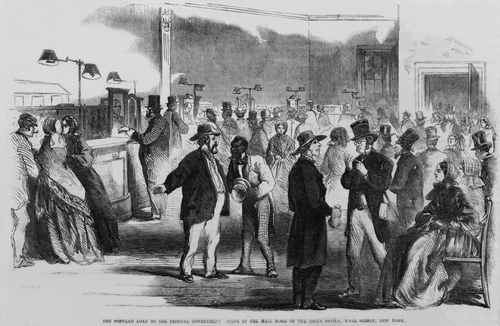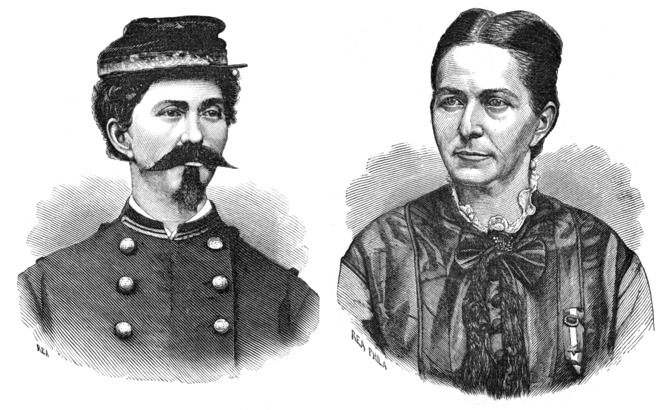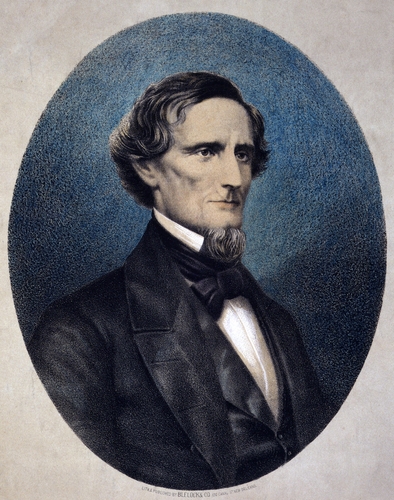
Life in the South during the Civil War was very difficult for people. The new government issued money to help pay for the war, but the result was a crippling inflation. Prices went sky high, and most could not afford basic needs. Much of the materials needed for the soldiers, such as clothing and weaponry, were manufactured in the North, so they were unable to come by these items, particularly shoes. The Confederate government issued a draft, but it seemed that the rich were excluded from having to fight. Women's roles in the South were changing as well. Like their Northern counterparts, they too were needed to fill a number of jobs, including nursing.
Read the following information about the Southern homefront and take notes.

Loreta Janeta Velázquez as herself (right) and disguised as Lieutenant Harry T. Buford (left); image published in The Woman In Battle: a Narrative of the Exploits, Adventures, And Travels of Madame Loreta Janeta Valezquez, Otherwise Known As Lieutenant Harry T. Buford, Confederate States Army; Richmond; Dustin, Gilman & Co., 1876.
While everyday life in the North suffered little disruption, life in the South was dramatically changed. The fighting and the ever-tightening blockade disrupted everyday life. Those who lived in the paths of marching armies lost crops and homes. The South also had depended on the outside world for everything. As the war dragged on, shortages became more commonplace. The South ran out of almost everything. Shortages in feed for animals and salt for curing meant that little meat was available. Shortages in meat were matched by shortages in clothing, medicine, and even shelter. Things became bad enough that women began to riot over food in southern cities.
Southern women also found themselves filling the work gap for fighting soldiers. Some, however, wanted to be more involved. Some women were spies. While Harriet Tubman spied for the North, Rose O’Neal Greenhow entertained Union leaders in Washington, D.C., picking up information about Union plans that she passed to the South. Greenhow was caught, convicted of treason, and exiled. Belle Boyd, of Front Royal, Virginia, informed Confederate generals of Union army movements in the Shenandoah Valley. Some women disguised themselves as men and became soldiers. Loretta Janeta Velázquez fought for the South at the First Battle of Bull Run and at Shiloh. Later, she became a Confederate spy.
Much like their northern counterparts, such as Clara Barton, southern women also sought to help soldiers. In the South, Sally Tompkins established a hospital for soldiers in Richmond, Virginia. Kate Cummings of Alabama was on the front lines and nursed the wounded in Corinth after the Battle of Shiloh.

Jefferson Davis, president of the Southern Confederacy
As the war dragged on, the number of volunteers declined. Enlisting enough soldiers became a problem, and both the Confederacy and the Union tried new measures. In April 1862, the Confederate Congress passed a draft law that required men between ages 18 and 35 to serve in the army for three years. A person could avoid the draft by hiring a substitute. Later, Congress exempted one white man on every plantation with 20 or more enslaved people. This led ordinary people to complain of “a rich man’s war but a poor man’s fight.” In reality, people from all levels of society served in both armies.
No disturbance as severe took place in the South, but many opposed the draft. The strong opposition led Jefferson Davis, the president of the Confederacy, to proclaim military law and suspend habeas corpus as Lincoln had done early in the war. Davis's action outraged Southerners who feared that they would lose the liberties for which they had gone to war.

Ruins in Charleston, South Carolina, during the Civil War
The Civil War is often called the first “modern” war because it required the total commitment of resources. Such a war has an impact on every part of life. However, the impact was more devastating on the South than on the North. The South struggled to carry out its war effort. Its government encouraged factories to supply arms and ammunition, but the South lacked the industry to provide other necessities. The economy of the South suffered far more than that of the North. Because most fighting occurred in the South, Southern farmland was overrun, and rail lines were torn up. By the end of the war, large portions of the South lay in ruins and thousands of people were homeless. The North’s blockade of Southern ports caused severe shortages of essential goods. A scarcity of food led to riots in Atlanta, Richmond, and other cities. Inflation, too, was much worse in the South. During the war, prices rose 9,000 percent, compared to a rise of 80 percent in the North.
The South borrowed more than $700 million. It issued so many bonds that people stopped buying them. Both sides imposed new taxes as well. When Southern states did not provide sufficient funds, the Confederacy also imposed an income tax. Because neither borrowing nor taxes raised enough money, both sides began printing paper money. The Confederacy also issued paper money, several times the amount printed in the North.
| Why was the winter so hard on the Confederate soldiers? | The South did not produce wool, and the Union navy blocked wool from reaching the South. This meant that the soldiers did not have warm winter clothing. |
| Why did prices in the South increase by 9,000%? | The Confederate government printed money, which led to major inflation. |
| Why was the draft so unpopular? | It allowed wealthy men to avoid the service, while the poor families had to suffer without the men. |
